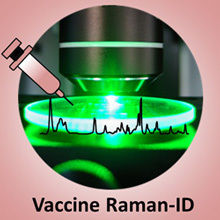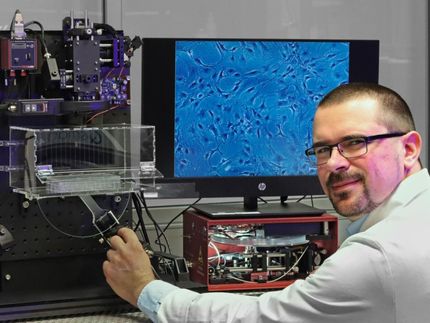Raman spectroscopy allows fast analysis of vaccines
vaccines are complex biomedicines composed of a number of different molecules. In the manufacturing process and before marketing authorisation, extensive research is required to verify the identity, quality, efficacy and safety of the products. Fast, cost-effective yet reliable analytical methods are necessary and can contribute to fighting against counterfeit medicines. Researchers from the Paul-Ehrlich-Institut (PEI) have shown with scientists from Jena that Raman spectroscopy is a suitable tool for this.

The Raman spectroscopic signature contains information of all the components in the vaccine and can be used for quick identification using machine learning.
Friedrich-Schiller-Universität Jena
The production of vaccines is time consuming and requires high quality controls to guarantee quality, safety and efficacy. Even vaccines against a single pathogen consist of different components or substances. Components of combination vaccines are even more complex.
Each vaccine has a characteristic composition. The vaccines are tested for their components, their quality, efficacy and safety both during production and before marketing authorisation within the scope of the mandatory batch testing by the PEI.
PEI researchers around Prof. Dr. med. Isabelle Bekeredjian-Ding, Head of the Department of Microbiology, in collaboration with scientists from the Friedrich Schiller University Jena and the Leibniz Institute for Photonic Technologies headed by Prof. Dr. Jürgen Popp investigated to what extent Raman spectroscopy can be used for the identification and differentiation of vaccines.
In Raman spectroscopy, molecules or solids are exposed with laser light. The inelastic scattering of the light and the associated differences in frequency with the incident light allow conclusions to be drawn about the examined substance. The so-called molecular fingerprint allows the quick and easy identification of any molecule. The method is used, for example, to study the material properties of semiconductors or for infection diagnostics. The process is also used in the quality control of chemical medicines (tablet form), in drug manufacturing (fermenter) and for the identification of counterfeit medicines.
Researchers applied Raman maps to analyze specific Raman signatures from air-dried samples of combination vaccines containing antigens from tetanus, diphtheria, and pertussis (DTaP vaccines). In fact, the vaccines could be identified and distinguished using these specific signatures.
The investigations confirm that Raman spectroscopy can be used to analyse and classify manufacturer-specific vaccine preparations as an analytical method. The results provide a good starting point for the development of a simple and reliable test system for vaccine identification and quality control.
Original publication
Other news from the department science
Most read news
More news from our other portals
See the theme worlds for related content
Topic World Spectroscopy
Investigation with spectroscopy gives us unique insights into the composition and structure of materials. From UV-Vis spectroscopy to infrared and Raman spectroscopy to fluorescence and atomic absorption spectroscopy, spectroscopy offers us a wide range of analytical techniques to precisely characterize substances. Immerse yourself in the fascinating world of spectroscopy!

Topic World Spectroscopy
Investigation with spectroscopy gives us unique insights into the composition and structure of materials. From UV-Vis spectroscopy to infrared and Raman spectroscopy to fluorescence and atomic absorption spectroscopy, spectroscopy offers us a wide range of analytical techniques to precisely characterize substances. Immerse yourself in the fascinating world of spectroscopy!


















































